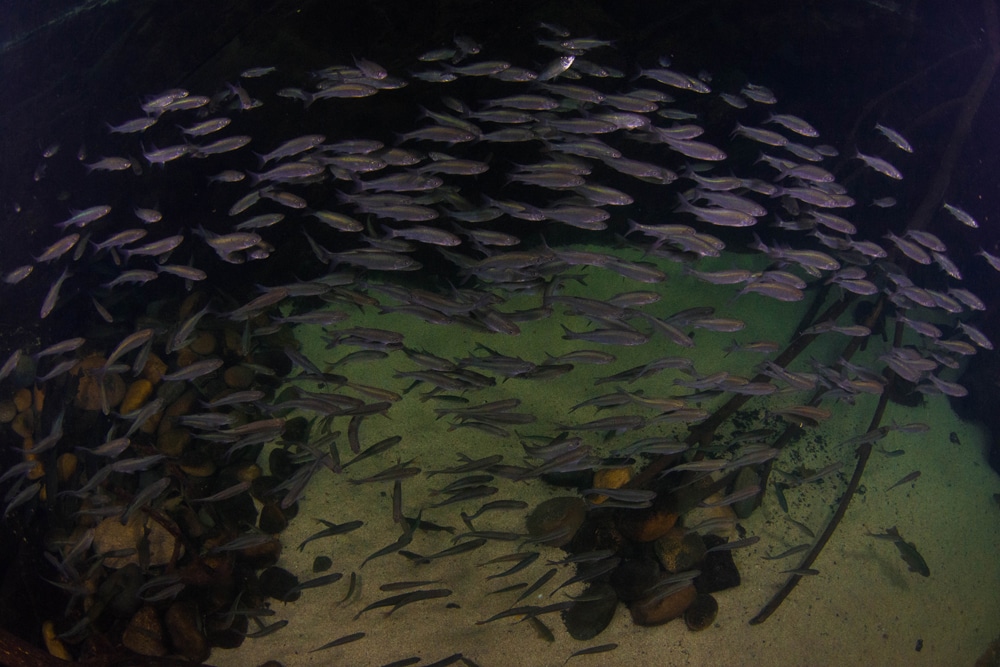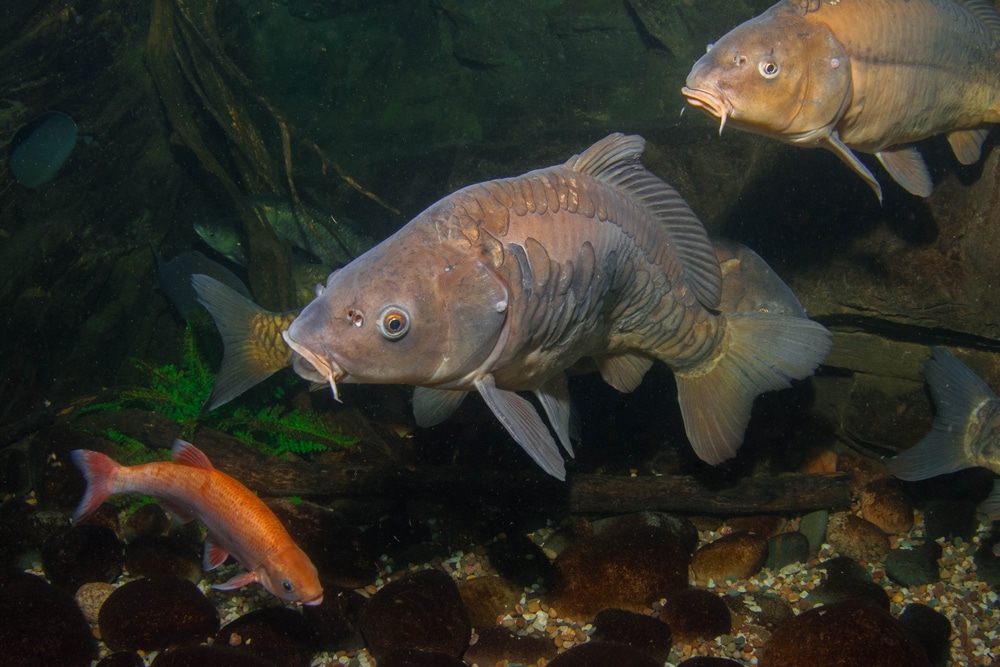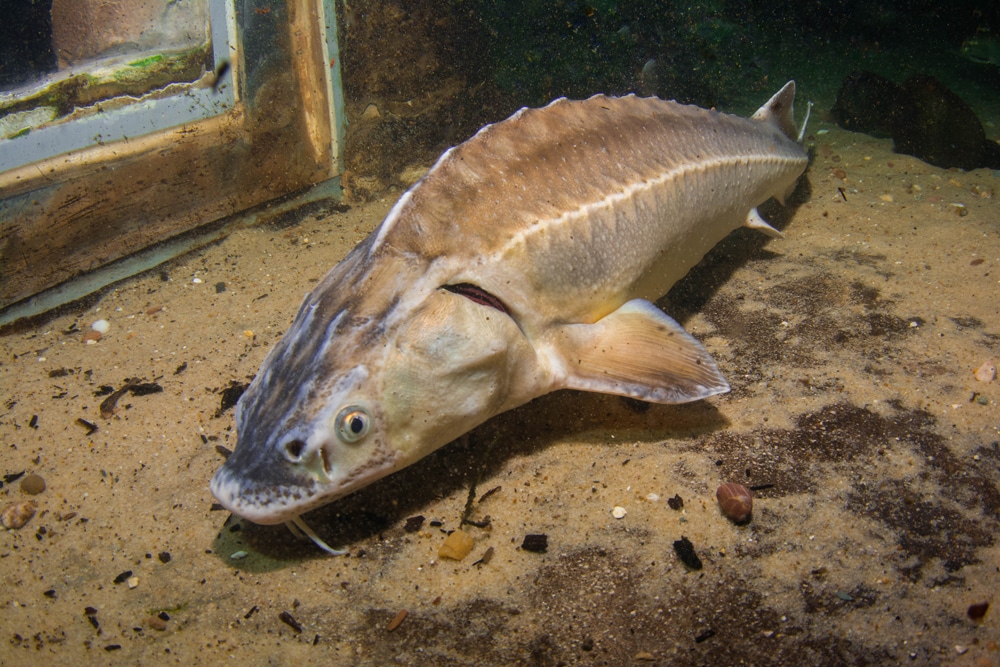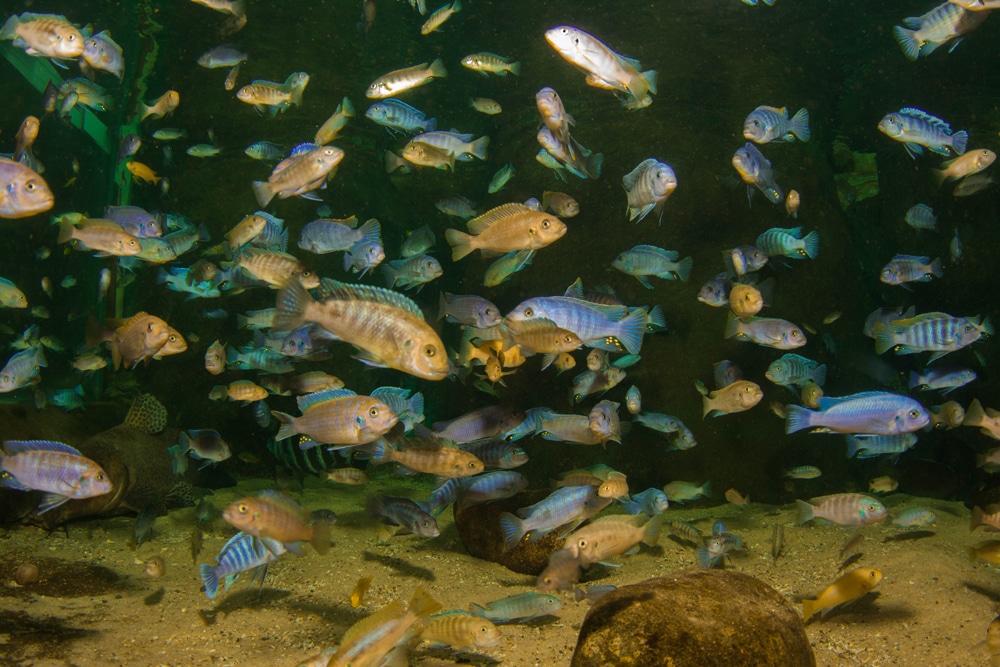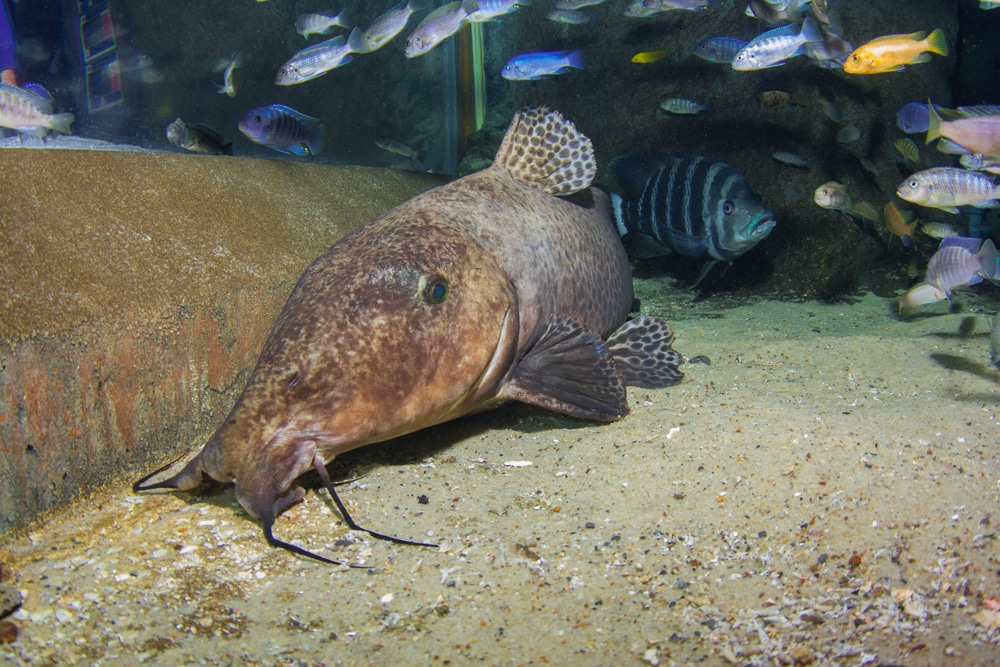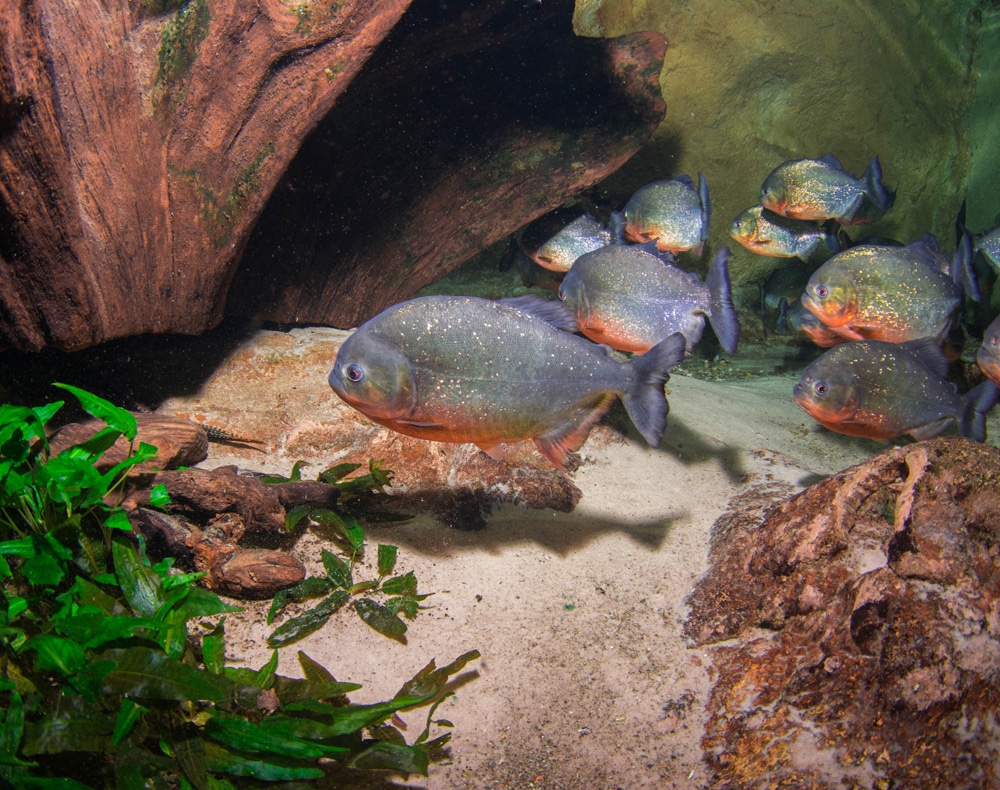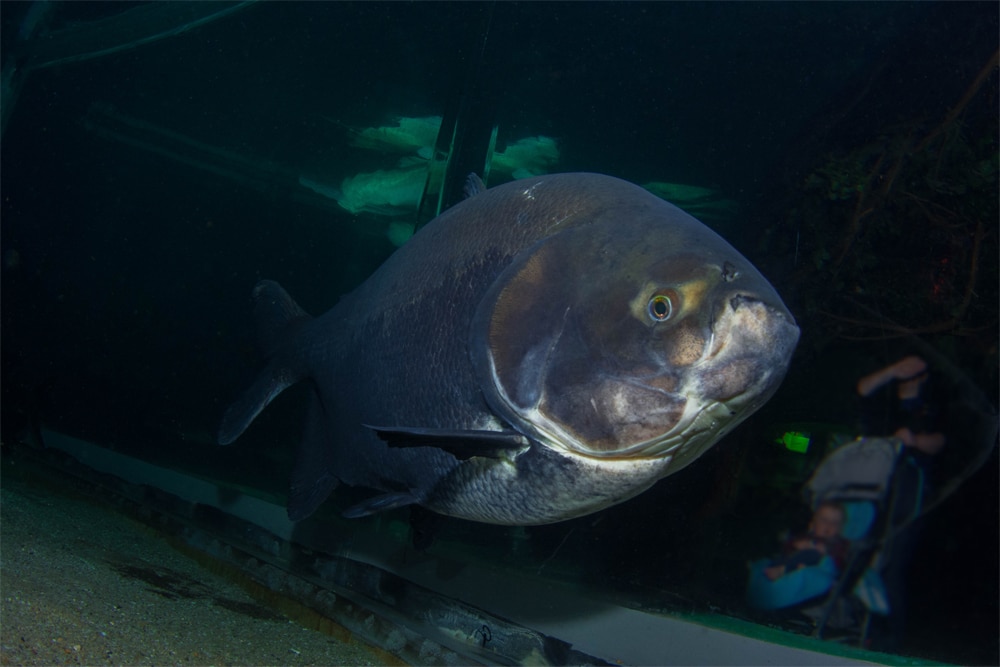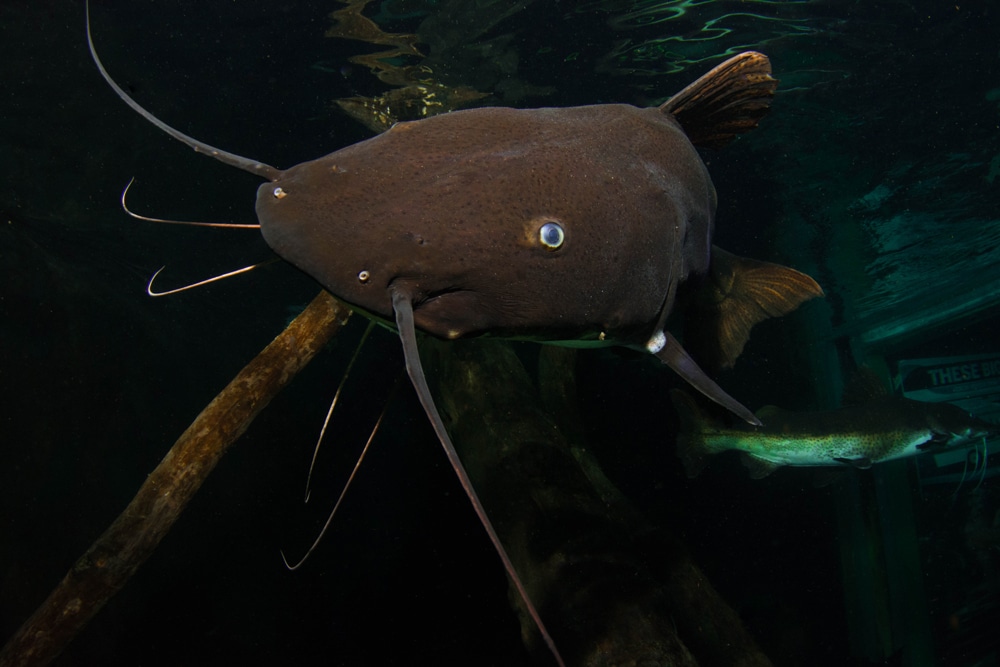Marine Life & Conservation Blogs
Blue Planet Aquarium’s Freshwater Oddballs

In the last few Blogs I’ve covered our Main Tank here at Blue Planet quite extensively, but I haven’t really managed to show you some of our other inhabitants. In this blog I want to show you some of the animals we have in our freshwater tanks and seen as half of the Aquarium is freshwater its pretty fair to say that we have quite a few of them.
When Blue Planet Aquarium was built back in 1998 it was built to loosely replicate the water cycle, so our first area is an area that mimics highland streams and rivers, before it moves down through the Jungles and Rainforests, then into the world’s great Lakes and finally the mangrove swamps and brackish swamps… before finally ending up in the ocean.
The first area we’re going to talk about is the first zone at the aquarium and that’s Northern Streams. This area is themed around highland rivers and streams and is mainly British Freshwater species including Carp, Sticklebacks, Sturgeon and Silver Orfe. The exhibit is split into three sections with different species in each section. Each section is split by a wall with a small gap over the top with fast flowing water. This is to imitate the natural currents that the animals would get in the wild and they do have the option to swim over them if they want too.
In this exhibit we have around 250 Silver Orfe and a handful of Golden Orfe or as they’re otherwise globally known as “Ide”. They’re a species that need fast flowing water with lots of oxygen and swim between the three sections all the time. We also have Common and Silver Carp, which are a large relative of the Goldfish. Carp are famous through Course Fishing and are immensely powerful; they’re among peoples favourites due to their quite comical expressions and being one of the largest fish in Northern Streams.
My personal favourites in this area are the two species of Sturgeon: we have both Russian or “Diamond” Sturgeon and Siberian Sturgeon. You may be familiar with these guys as they’re a fish that look incredibly similar to a Shark and have been around for millions of years. We know this as they lack a first Dorsal fin in the same way that Six-gill and Seven-Gill Sharks do; these fish are also one of a few species from which we get Caviar. They are a bottom dwelling fish and feed by using their sensitive noses to forage through the mud for worms and small Crustaceans.
The next area is Lake Malawi (not the real one) but an area of the aquarium that’s themed around the great lake in Africa. Lake Malawi has a surface area of 29,600 km² and is 580km Long with its max depth being 700m. This makes Lake Malawi the ninth largest lake in the world and is the third largest and second deepest in Africa. Lake Malawi houses more fish species than any other lake in the world with the number of Cichlids alone sitting at around 1500sp although at Blue Planet we only a house a mere handful of these.
Cichlids are famous for the way in which they breed, Cichlids are known as mouth brooders as the females store/incubate and rear their young in their mouths. The females do this until the young start to become too large for all the Fry to be stored in the mouth and at this point she will start to kick them out so they can stretch their fins and build up their strength, but if they’re not quick enough to get back in when a predator comes then they are at risk of being eaten. Our Cichlids are housed alongside other animals such as a Giraffe Catfish who naturally would be found in the Nile River but were released into Lake Malawi. Ours is incredibly friendly and will come to the surface and wait, mouth agape, for his food.
The next and final area is of course the Amazon Area. Now if you were to walk through the aquarium you would go through this area first before Lake Malawi, but I wanted to leave the largest of our freshwater fish until last.
In this area we have some of our most charismatic Freshwater species such as our Red-Bellied Piranhas. These fish are surrounded by quite negative media attention which is something that isn’t deserved. The rumours surround that these fish eat people and can strip a human in 10 seconds but that is greatly exaggerated.
Piranhas are more scavengers and due to this are nicknamed the “Hyenas of the Amazon”. They prefer to eat the dead, dying or severely injured, this is due to their small size and the fact that they are not very high up the food chain, meaning that they’re targeted by many predators that live in the Amazon. They usually send up a scout to check the prey or food and once the scout has taken the first bite to show its clear, the rest of the pack follow. A Piranhas’ bite is incredibly powerful and so powerful that in comparison to body size, Red-Bellied Piranhas have a stronger bite than that of T-Rex and Megalodon. The myth that they can strip a human in seconds is mainly science fiction, but they can still strip a small carcass in just a few minutes.
The final Exhibit I’m going to mention is the Flooded Forest tank. This is the one that houses the aquarium’s largest freshwater fish. In this tank we have some of the most charismatic and popular fish in the aquarium, such as the Black Pacu, which is the world’s largest species of Piranha. When these fish are young they have bright red bellies to mimic the Red-Bellied Piranha and as they get bigger they lose this colour and turn a dark colour.
People buy these fish thinking that they’re getting Piranhas, but owners soon realise there’s something amiss when they swap some meat for some carrots and cabbage. They can also grow up to be around 3 ½ Feet in length and weigh in at a hefty 60 pounds, we have one in the exhibit around this size that has come to be called “Moby”. The tank is home to a number of fish that have been rescued over the years and a lot of the fish in the tank were all either mis-sold or sold under a false name, leading to the tank being nicknamed ‘Tank Busters’. Sharing the tank with the Pacu’s we also have Tiger Shovelnose Catfish who were very intent on looking at their reflection in the dome port of my camera when I got in to take some of the photos used in this blog. Once again these fish are also rescues from owners who could no longer care for them.
We also have a handful of Silver Arowana and of course the Freshwater Stingrays. We have two species at Blue Planet: the Amazonian Stingray which is Brown with orange spots and the Xingu River Ray which is black with white spots. These Stingrays have the slightly annoying habit of trying to sleep under your feet when you’re trying to clean the windows and sand, so we must be extra careful not to step on them.
So, there you have it, our Freshwater Oddballs here at Blue Planet Aquarium. It’s amazing to have several different species over many different environments and I’m glad that I have been able to introduce you to some of the aquarium’s different inhabitants. Check out the next blog to meet our Jellyfish Breeder and to see how we breed our Moon Jellyfish.
For more information about the Blue Planet Aquarium please visit their website by clicking here.
Blogs
Saba’s Plan for a Coral Comeback

Saba has an exciting new initiative to restore its coral reefs. This new project, running from 2024 to 2026, will focus on reviving key species in the island’s underwater ecosystems. With a collaborative team from the Saba Conservation Foundation (SCF) and Van Hall Larenstein (VHL) University of Applied Sciences, the project aims to restore both corals as well as sea urchins.
This initiative is centered around coral restoration, specifically reviving two essential coral species—staghorn coral (Acropora cervicornis) and elkhorn coral (Acropora palmata). By mapping parent colonies and using a technique known as coral gardening, SCF will create and maintain coral nurseries. These corals will eventually be outplanted at key reef sites around Saba to not only expand the number of coral colonies, but also provide essential fish habitat. The project focusses on installing coral nurseries, training staff with the newest techniques and starting with the restoration of key reef sites.

Reef Cleaners to the Rescue
It’s not just corals getting a makeover—this project also shines a spotlight on the essential role of grazers, particularly sea urchins. VHL is leading the charge on cultivating and restocking two key sea urchin species, West Indian sea egg (Tripneustes) and long-spined sea urchin (Diadema), known for their ability to keep algae in check. By removing algae, which are important competitors of corals, they help the coral to thrive. By restoring these “reef cleaners,” Saba’s project will give corals the breathing room they need to grow, setting the stage for a healthier, more balanced marine ecosystem.
From Tiny Urchins to Big Goals
The project will be funded as part of the Dutch Government’s Nature and Environment Policy Plan (NEPP) 2020-2030 for the Caribbean Netherlands, a comprehensive initiative aimed at conserving and restoring the unique natural environments of the Dutch Caribbean islands, including Saba, St. Eustatius, and Bonaire. This project is aiming for big milestones: build and maintaining coral nurseries, the expansion of urchin cultivation facilities, and the creation of a dedicated research center. By 2026, the project hopes to ramp up coral and grazer restoration, with the ultimate goal of extending these efforts across the Dutch Caribbean. By linking local initiatives to broader regional goals, Saba’s restoration project promises to leave a lasting impact on both the environment and the community.
Find out more about the DCNA at dcnanature.org.
Blogs
Reef-World marks two decades of marine conservation: strengthening impact amid coral reef threats

Empowering ocean stakeholders to tackle future challenges and ensure the survival of coral reefs and humanity
2024 marks the 20th Anniversary of The Reef-World Foundation’s tireless efforts for global coral reef conservation. The UK charity is the international coordinator of the UN Environment Programme’s Green Fins initiative, known as the leading voice in sustainable marine tourism. Today, Reef-World released its 2023-2024 Impact Report outlining a year of substantive growth and impact in its marine conservation programmes.

Impact Report Highlights:
- Impressive improvements in environmental behaviours to protect coral reefs by the marine tourism industry as the global participation of Green Fins increases.
- Continued capacity building for government and NGO staff to effectively manage marine tourism activities in Asia, Caribbean and Red Sea regions.
- For the first time in Green Fins’ 20-year history, tourism operators have achieved ‘Best Environmental Performer’ status by demonstrating the lowest possible environmental impact in their environmental assessments. In 2024, three dive operators achieved this challenging milestone.
- Significant increases in global participation of Reef-World’s innovative digital conservation tools.
- 138 Green Fins dive operator members achieved the strict threshold for PADI Eco Center recognition.
- Developed four new educational materials and translated two into 16 languages to support the marine tourism industry in achieving sustainability targets.
- Establishing a new Reef-World Development strategy and recruiting new roles – Development and Programmes Managers.
- Reef-World’s board welcomes new Chair and Trustees strengthening organisational leadership.

Reef-World started as a one-person mission to inspire and empower communities to act in conserving and sustainably developing coral reefs and related ecosystems. Today, the team of 12 continues to meet this mission by inspiring and empowering the global marine tourism community to be exemplary sustainability leaders by using the Green Fins guidelines and tools to simultaneously use and protect the world’s precious reefs.
In April 2024, the fourth global coral reef bleaching event was confirmed. Reef-World’s work has never been more urgent as the marine environment, and the benefits they provide humanity, continue to be eroded by global threats. The reduction of local threats, like those from the marine tourism industry, is an essential step to ensuring a future where coral reefs survive and continue to support the millions of people who depend on their ecosystem benefits. Reef-World’s work buys time for coral reefs and related ecosystems to be resilient to the impacts of global threats.
“Right now our corals are facing the greatest fight of their existence as the terrifying predictions of the steps towards their complete extinction are starting to come true. But all is not lost, reefs are resilient and they have existed on this planet for millions of years. We must take action now, to buy time for reefs by reducing threats facing them and allowing them to react and adjust to the changing environment they need to survive in.” – Chloe Harvey, Executive Director
Looking Forwards:
Like coral reefs, the Reef-World team needs to be resilient in the face of the complex challenges of the conservation sector. Reef-World has invested significantly in developing a Culture of Care to ensure the well-being of its team on a daily basis, continuing to be an exemplary employer to enable its team to best achieve the mission for coral reef conservation.
With the foundations of a Culture of Care and organisational development laid, Reef-World is emerging from the end of a natural organisation life cycle, that brings the challenges of growth and scale, stronger than ever. With a new strategy in place to generate much needed resources, Reef-World is excited for the opportunities to leap forward, continue to scale our impact and lean into new innovations and untapped opportunities for marine conservation.
We continually strive to become a forward-thinking organisation that delivers on our goals and commitments to our stakeholders with fresh approaches and not being afraid of steering away from a “normal approach.” This approach is not only applied to our programmes of work but also internally and carries over to our Culture of Care for our team.” — JJ Harvey, Operations Director

The Reef-World Foundation is immensely grateful for the continued support of its grant funders: UN Environment Programme, IUCN’s Blue Natural Capital Financing Facility, Adventure Travel Conservation Fund, PADI Aware Foundation, and World Nomads Footprints Program.
Reef-World would also like to express its gratitude to international partners whose vital support has resulted in significant tangible benefits for our work and mission: PADI; Professional SCUBA Schools International (PSS); Explorer Ventures; 1% for the Planet; ZuBlu; Snorkel Venture, GSTC; Dive O’Clock; Seven Dragons; DiveAssure and Eco Beach, without whom these achievements would not be possible.
The full 2023–2024 Annual Impact Report is available on Reef-World’s website.
-

 News2 months ago
News2 months agoIconic SS United States to become the World’s Largest Artificial Reef
-

 News3 months ago
News3 months agoBook Review – 52 Assignments: Underwater Photography
-

 Gear News3 months ago
Gear News3 months agoDYNAMICNORD – New German diving brand enters the British market
-

 News3 months ago
News3 months agoExploring Cenote El Pit: A Diver’s Dream
-

 Gear News3 months ago
Gear News3 months agoTry BARE drysuits (and maybe even win one!) this Friday with Sea & Sea at North West Dive Fest
-

 Marine Life & Conservation3 months ago
Marine Life & Conservation3 months agoBook Review: Coral Triangle Cameos
-

 Blogs2 months ago
Blogs2 months agoDive the Egyptian Red Sea this Autumn with Regaldive
-

 News3 months ago
News3 months ago2024 Ocean Art Underwater Photo Competition Announced


